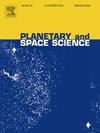Mineralogy, geochemistry and morphology of Arctic gossans on Axel Heiberg Island, NU, Canada: Spectroscopic investigation and implications for Mars
IF 1.7
4区 物理与天体物理
Q3 ASTRONOMY & ASTROPHYSICS
引用次数: 0
Abstract
Gossans are formed through the oxidation of sulfide ore deposits by fluids, such as meteoric water or hydrothermal solutions, leading to locally acidic conditions. In permafrost regions, gossans undergo seasonal chemical weathering after their initial formation (reactive gossans), potentially providing a sustained energy source for microbial activity. Arctic gossans are therefore considered valuable analogs for Martian paleo-hydrothermal systems and promising astrobiological targets. While hundreds of gossans have been identified in the Arctic, few have been studied in detail and even fewer using rover-compatible remote sensing techniques. This study aims to characterize the morphological profile of seven Arctic gossans located at Expedition Fiord (Axel Heiberg Island, Nunavut), as well as their geochemistry, mineralogy and organic carbon content using X-ray fluorescence, X-ray diffraction (XRD), Visible (VNIR) to thermal infrared (MIR-TIR) reflectance and Raman spectroscopy. Results showed a dominance of silicon, calcium and iron. Mineralogical analyses revealed gypsum and quartz as major phases, with variable amounts of silicates, sulfates, iron sulfides and iron oxyhydroxides. Raman spectroscopy detected organic carbon in most samples, up to 50 cm deep, in various organo-mineral complexes. XRD was the only technique to detect iron sulfides. VNIR-MIR-TIR reflectance and Raman spectroscopy provided mineralogical results consistent with XRD. All gossans displayed classical profiles, with alteration zones overlying primary sulfides, but showed diverse color and compositional stratification patterns. These variations suggest local mechanisms influence mineral and associated organic carbon distribution. Further investigations should focus on better understanding these local variations, which could guide the search for biosignatures in gossan-like features on Mars.
加拿大阿克塞尔海伯格岛北极蛛丝的矿物学、地球化学和形态:光谱调查及其对火星的影响
Gossans是通过流体(如大气水或热液溶液)氧化硫化物矿床形成的,导致局部酸性条件。在永久冻土区,蛛丝在初始形成后经历季节性化学风化(活性蛛丝),可能为微生物活动提供持续的能量来源。因此,北极蛛丝被认为是火星古热液系统和有前途的天体生物学目标的有价值的类似物。虽然在北极已经发现了数百种蛛丝,但对它们进行详细研究的很少,使用与漫游车兼容的遥感技术的就更少了。本研究旨在利用x射线荧光、x射线衍射(XRD)、可见(VNIR) -热红外(MIR-TIR)反射率和拉曼光谱,表征位于努纳武特探险峡湾(Axel Heiberg Island, Nunavut)的7种北极蛛的形态特征,以及它们的地球化学、矿物学和有机碳含量。结果表明,硅、钙和铁占主导地位。矿物学分析显示,石膏和石英为主要相,硅酸盐、硫酸盐、硫化铁和氧化铁含量不等。拉曼光谱在大多数样品中检测到有机碳,深度可达50厘米,在各种有机矿物复合物中。XRD是检测硫化铁的唯一方法。VNIR-MIR-TIR反射率和拉曼光谱的矿物学结果与XRD一致。所有丝织物均表现出典型的剖面,蚀变带位于原生硫化物之上,但颜色和成分分层模式各异。这些变化表明局部机制影响矿物和相关有机碳分布。进一步的研究应该集中在更好地理解这些局部变化上,这可以指导在火星上寻找类似戈桑的生物特征。
本文章由计算机程序翻译,如有差异,请以英文原文为准。
求助全文
约1分钟内获得全文
求助全文
来源期刊

Planetary and Space Science
地学天文-天文与天体物理
CiteScore
5.40
自引率
4.20%
发文量
126
审稿时长
15 weeks
期刊介绍:
Planetary and Space Science publishes original articles as well as short communications (letters). Ground-based and space-borne instrumentation and laboratory simulation of solar system processes are included. The following fields of planetary and solar system research are covered:
• Celestial mechanics, including dynamical evolution of the solar system, gravitational captures and resonances, relativistic effects, tracking and dynamics
• Cosmochemistry and origin, including all aspects of the formation and initial physical and chemical evolution of the solar system
• Terrestrial planets and satellites, including the physics of the interiors, geology and morphology of the surfaces, tectonics, mineralogy and dating
• Outer planets and satellites, including formation and evolution, remote sensing at all wavelengths and in situ measurements
• Planetary atmospheres, including formation and evolution, circulation and meteorology, boundary layers, remote sensing and laboratory simulation
• Planetary magnetospheres and ionospheres, including origin of magnetic fields, magnetospheric plasma and radiation belts, and their interaction with the sun, the solar wind and satellites
• Small bodies, dust and rings, including asteroids, comets and zodiacal light and their interaction with the solar radiation and the solar wind
• Exobiology, including origin of life, detection of planetary ecosystems and pre-biological phenomena in the solar system and laboratory simulations
• Extrasolar systems, including the detection and/or the detectability of exoplanets and planetary systems, their formation and evolution, the physical and chemical properties of the exoplanets
• History of planetary and space research
 求助内容:
求助内容: 应助结果提醒方式:
应助结果提醒方式:


